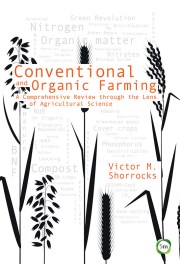Conventional And Organic Farming: A Comprehensive Review Through The Lens Of Agricultural Science
 Victor M Shorrocks
Victor M Shorrocks
Old Pond Publishers, £55.00
UK farming is progressively adopting husbandries that are environmentally beneficial.
In this process, aspects of organic production are being interwoven with conventional systems. Sustaining financial profitability while conserving the flow of natural capital will permit the continuation of yield and quality increases that are essential for feeding expanding populations. Victor Shorrocks' book is a major contribution towards attaining these goals.
The author is an agricultural scientist who specialises in understanding crop nutrition largely from a commercial perspective. He has used his knowledge and expertise wisely and confidently in a detailed analysis that bridges the tenets of conventional and organic methods.
Over 20 chapters and 574 pages, this book confidently sifts through the evolutionary pathways underpinning these apparently divergent husbandries. Their analysis is presented in five parts: 'From Hunter Gatherers to Agricultural Science'; 'The Nature, Origin and Benefits of Organic Farming'; 'Comparison of Organic and Conventional Farming'; 'Nitrogen: the All-Important Element'; and 'Sustaining Adequate Food Production and the Future'. Each chapter is rounded off with a summary and extensive references.
Shorrocks' epilogue draws out the key messages from his weighty scholarship. He emphasises the essential reliance of farming on agricultural science, particularly in aspects of breeding, nutrition and crop protection. Alongside this, he recognises the essential importance of healthy soils, the value of beneficial microbes, and the continuing and increasing responsibilities of small-scale farming in achieving sustainable global food supplies.
These factors he weighs against the necessity for large-scale agriculture in the developed world, and the paucity of verified evidence that wholly organic systems are preferable to environmentally cautious and competent conventional systems.
Hopefully, at least some of the proponents of wholly organic systems will accept the veracity of the author's arguments, while supporters of conventional methods should recognise the values of adopting methods that avoid environmental damage. For far too long there have been entrenched attitudes, especially from the 'organic movement'.
If this book helps break down these barriers, then Shorrocks' toil will have
been worthwhile. Conventional and Organic Farming is a book for all sectors – practising farmers and growers, students, scientists and those members of the public who want to understand the economic, environmental and social importance of agriculture.
Professor Geoffrey R Dixon FRSB


